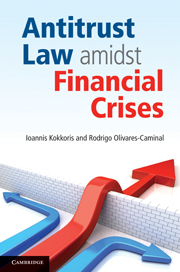Book contents
- Frontmatter
- Contents
- Foreword by Philip Lowe
- Foreword by Frederic Jenny
- Preface
- Table of cases
- Table of treaties and other international instruments
- Introduction
- 1 Introduction to competition law: EU, US and UK
- 2 Some notes on crises
- 3 Failing-firm defence
- 4 Efficiencies
- 5 Crisis cartels
- 6 State aid (Phedon Nicolaides)
- 7 Competition enforcement in periods of crisis
- 8 Conclusion
- Index
2 - Some notes on crises
- Frontmatter
- Contents
- Foreword by Philip Lowe
- Foreword by Frederic Jenny
- Preface
- Table of cases
- Table of treaties and other international instruments
- Introduction
- 1 Introduction to competition law: EU, US and UK
- 2 Some notes on crises
- 3 Failing-firm defence
- 4 Efficiencies
- 5 Crisis cartels
- 6 State aid (Phedon Nicolaides)
- 7 Competition enforcement in periods of crisis
- 8 Conclusion
- Index
Summary
What we know about the global financial crisis is that we don't know very much.
Paul A. Samuelson (1915–2009)Global capital markets pose the same kinds of problems that jet planes do. They are faster, more comfortable, and they get you where you are going better. But the crashes are much more spectacular.
Lawrence H. SummerIntroduction
In September 2006, Professor Nouriel Roubini, better known by the nickname of ‘Dr Doom’ he had acquired through pessimistic and gloomy predictions, announced to an audience mainly of economists at the International Monetary Fund (IMF) that a crisis was imminent: the bursting of the housing bubble would seriously affect the US, causing a broad, international recession. His audience was largely sceptical and even dismissive. In the year that followed, the world was swept by the most severe financial crisis in several generations.
In view of the magnitude of the crisis and its relevance, this chapter seeks to explain what a crisis is. First, the chapter attempts to define a crisis, analysing its characteristic elements. Second, it explores different types of crisis, such as social, political, environmental, financial, economic and so on. Third, it analyses the similarities and differences between financial and economic crises. In this analysis, it is observed that there are no precise parameters for the existence or imminence of a crisis, only rather warnings of it.
- Type
- Chapter
- Information
- Antitrust Law amidst Financial Crises , pp. 72 - 102Publisher: Cambridge University PressPrint publication year: 2010

